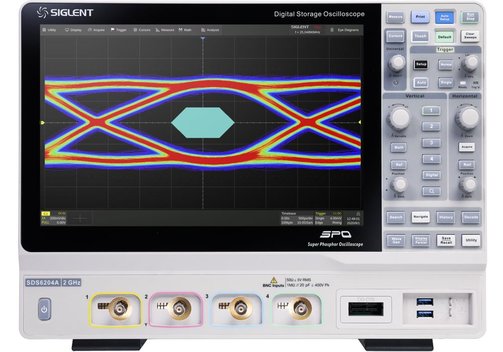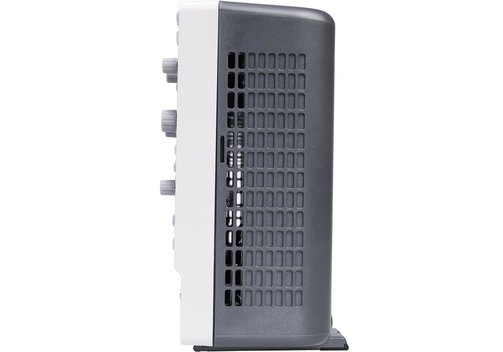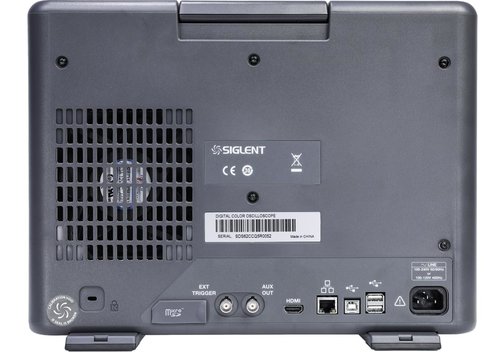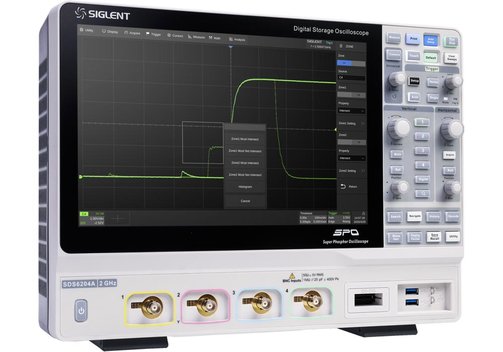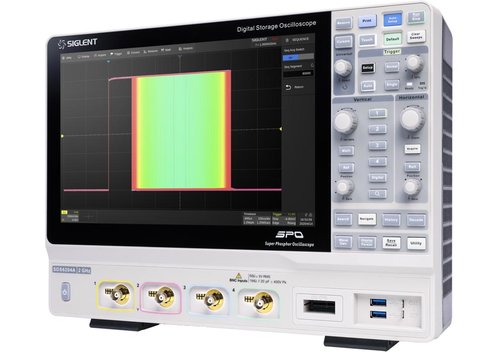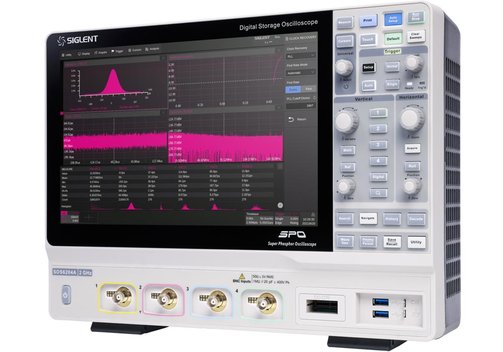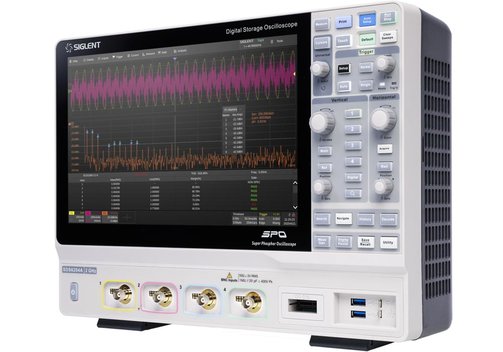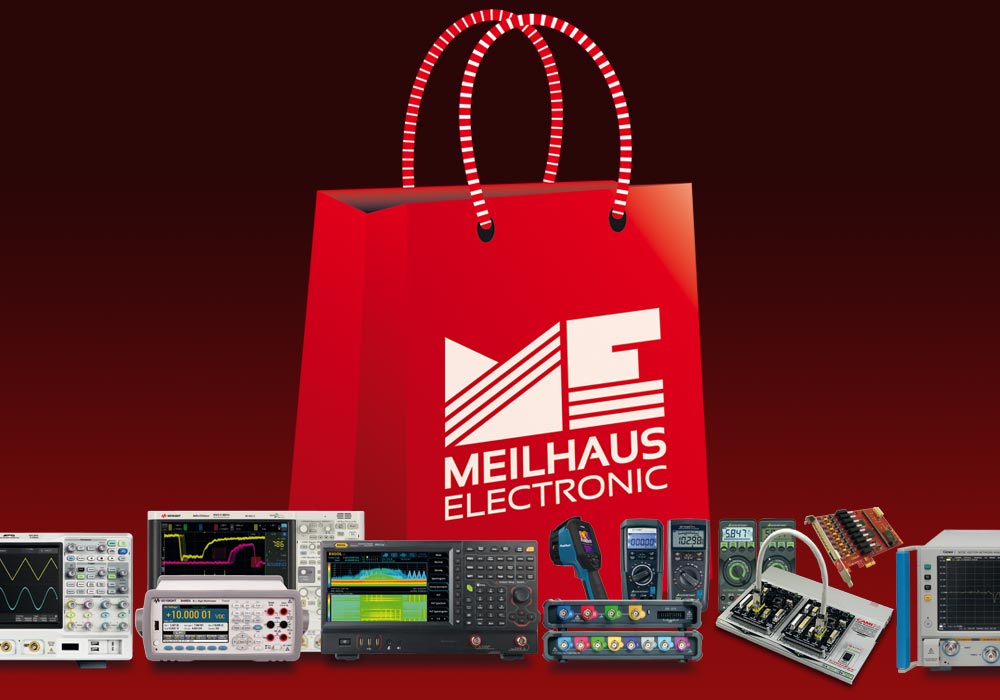Siglent SDS6054A, SDS6104A, SDS6204A Mixed-Signal Oscilloscopes up to 2GHz
Benefits of the Siglent SDS6000A 500 MHz/1 GHz/2 GHz High-end Oscilloscopes
- Large, high-resolution 12.1"/30.74 cm multi-touch screen.
- Fast, advanced processor for optimal performance.
- High-quality input section for precise measurement results.
Siglent SDS6000A Mixed-Signal Oscilloscope Series up to 2 GHz
Models Siglent SDS6054A, SDS6104A, SDS6204A
With the SDS6000A series, Siglent enters a new level of their oscilloscope technology. Immediately eye-catching is the large, high-resolution touchscreen display that makes everyday work really fun and reveals fine details. The 4-channel instruments offer bandwidths up to 500 MHz, 1 GHz, or 2 GHz. High-quality technical data is ensured by a fast, modern processor system and channels with individual A/D converters for sample rates per channel up to 5 G/s are possible (in ESR mode up to 10 GS/s). A high-quality input section forms the basis for precise measurements in research, development and debugging. The devices already offer many important additional functions as standard, but can be further expanded with options such as MSO/logic analysis, eye diagram and jitter analysis, Bode plot, etc.
- High-end oscilloscope for research, development, debugging.
- With large, high-resolution 12.1"/30.74 cm multi-touch screen.
- 4 analog inputs with bandwidths up to 500 MHz, 1 GHz, or 2 GHz.
- 5 GS/s sample rate per channel - no halving/reduction of sample rate for two/more channels!
- Up to 500 Mpts/ch memory depth.
- Segmented memory; dead time only 1.3 µs.
- 170,000 wfm/s acquisition rate and record/playback of up to 80,000 frames of waveform frames.
- 4 math traces.
- 8 Mpts hardware accelerated FFT.
- Sophisticated trigger functions.
- Mask test, optional eye diagram, jitter analysis.
- Bode plot/frequency response with optional signal generator.
- Serial bus decoding (2 buses simultaneously) I2C, SPI, UART, CAN, LIN, optional CAN FD, FlexRay, I2S, MIL-STD-1553B, SENT, Manchester.
- Built-in DVM and 7-digit counter and totalizer.
- HDMI output.
- USB host & decive (2.0 and 3.0), LAN/Ethernet web remote control and micro SD card slot as standard.
Model Overview
| Model | SDS6054A | SDS6104A | SDS6204A |
| Channels | 4 (BNC); EXT trigger (BNC); 16 additional digital/logic channels with MSO option (used as source for serial trigger, serial decode, math, and measurement functions) | ||
| Bandwidth | 500 MHz | 1 GHz | 2 GHz |
| Sample rate | 5 GS/s each channel (10 GS/s with ESR/enhanced sample rate) | ||
| Memory depth | 500 Mpts/ch (single channel), 250 Mpts/ch (dual-channel), 125 Mpts/ch (3 or 4 channels); segmented memory; dead time only 1.3 µs | ||
| Waveform capture rate | 170,000 wfm/s (normal mode), 750,000 wfm/s (sequence mode) | ||
| Vertical resolution | 8 bit | ||
| Analog inputs | Channel-to-channel isolation 70 dB up to 200 MHz, 60 dB up to 500 MHz, 50 dB up to 1 GHz, 40 dB up to 2 GHz; DC gain accuracy ±1.5%; SFDR (spurious free dynamic range) ≥45 dBc | ||
| More functions | 4 math traces; formula editor; up to 12 parameter statistics; histogram, trend and track; 8 Mpts hardware accelerated FFT; auto peakt detection; trigger: Edge, slope, pulse width, window, runt, interval, dropout, pattern, video, qualified, nth edge, setup/hold, delay, serial; trigger zones; trigger-based search conditions; one-key navigate; always in background history function (up to 80,000 frames of waveforms record and playback); mask test with build-in mask editor (up to 18,000 pass/fail decisions per second); Bode plot with optional signal generator (use additional waveform generator (recommended) such as Siglent SDG2000X, or use software + hardware option SDS6000Pro-FG and SAG1021I); serial bus decode (2 buses can be decoded simultaneously) standard I2C, SPI, UART, CAN, LIN, optional CAN FD, FlexRay, I2S, MIL-STD-1553B, SENT, Manchester; optional power analysis SDS6000A-PA; built-in DVM (DC mean and RMS, AC RMS, peak-peak, amplitude; bar, histogram, trend plot) and built-in 7-digits counter and totalizer | Option: Eye diagram, jitter analysis option | |
| MSO function | (Software option) maximum sample rate up to 1 GS/s; record length up to 50 Mpts; logic probes available as optional accessories | ||
| Display | 12.1"/30.74 cm capacitive touch screen with multi-gesture control (1280x800), backlight intensity adjustable; adjustable channel trace colours; HDMI output | ||
| Interfaces | USB Host & Decive: 2x USB 3.0 Host, 2x USB 2.0 Host, USB 2.0 Device; LAN/Ethernet remote web control; Micro-SD card | ||
| Dimensions (mm) | 379 x 288 x 159; approx. 5.5 to 7.1 kg | ||
Included: Siglent SDS 6054A, 6104A, or 6204A, power cord, USB cable, 1x passive probe (SP3050A), quick start guide, certificate of calibration, wireless mouse.
Siglent SDS6000A Options and Accessories
| Model | Description | Option type |
| SDS6000Pro-FG | 25 MHz USB function generator/arbitrary waveform generator software, eg. for Bode plot (only required, if SAG1021I is used; if additional benchtop waveform generator such as the Siglent ▸SDG2000X is used, this software option is not required) | Software/licence |
| SAG1021I | 25 MHz isolated USB function generator/arbitrary waveform generator module, 125 MS/s, 16 kpts arb. wave length, insulated voltage, ±42Vpk | Hardware |
| SDS6000Pro-16LA | MSO function software, 16-channel, 500 MS/s, 14 Mpts, logic probes not included | Software/licence |
| SPL2016 | Logic probes for 16 channels | Hardware |
| SDS6000Pro-PA | Power analysis: Power quality, current harmonics, inrush current, switching loss, slew rate, modulation, output ripple, turn on/off, transient response, PSRR, efficiency | Software/licence |
| DF2001A | Deskew fixture for voltage and current probes | Hardware |
| SDS6000Pro-EJ | Eye diagramm/jitter analysis (for SDS6204A only) | Software/licence |
| SDS6000Pro-I2S | I2S trigger and decode | Software/licence |
| SDS6000Pro-1553B | MIL-STD-1553B trigger and decode | Software/licence |
| SDS6000Pro-FlexRay | FlexRay trigger and decode | Software/licence |
| SDS6000Pro-CANFD | CAN FD trigger and decode | Software/licence |
| SDS6000Pro-SENT | SENT trigger and decode | Software/licence |
| SDS6000Pro-Manch | Manchester decode | Software/licence |
| SDS6000-4BW10 | Bandwidth upgrade 500 MHz to 1 GHz | Software/licence |
| SDS6000-4BW20 | Bandwidth upgrade 1 GHz to 2 GHz | Software/licence |
| SAP1000 | Active probe, >1 GHz; 1.2 pF/1 MΩ probe attenuation factor 1/10 | Hardware |
| SAP2500 | Active probe, >2.5 GHz; 1.1 pF/1 MΩ probe attenuation factor 1/10 | Hardware |
| SAP2500D | Active differential probe, >2.5 GHz; 1.0 pF/200 kΩ (differential)/100 kΩ (single-ended)/50 kΩ (common mode); probe attenuation factor 1/10 | Hardware |
| HPB4010 | High voltage probe | Hardware |
| DPB1300 DPB5150 DPB5150A DPB5700 DPB5700A | High voltage differential probes | Hardware |
| CPL5100 CP4020 CP4050 CP4070 CP4070A CP5030 CP5030A CP5150 CP5500 | Current probes | Hardware |
| STB3 | Demo signal source | Hardware |
| SDS6000-RMK | Rack mount kit for Siglent SDS6000A series oscilloscopes | Hardware |
| BAG-S2 | Bag for Siglent SDS6000A series oscilloscopes | Hardware |
Frequently Asked Questions:
Question: Why do I need an additional signal generator for the Bode Plot function and which one?
Answer: The Bode plot is a graphical representation of the transmission behavior of a system or its frequency response (named after Hendrik Wade Bode). In order to record the frequency response of a device under test, two devices are required: a signal source (here: signal generator) and a suitable measuring device (here: oscilloscope SDS6000A). The signal generator applies a test signal to the DUT that sweeps through the frequency range of interest. The oscilloscope measures the test signal at the input of the DUT and the output signal of the DUT, determines the frequency response from this and displays it graphically. The Siglent SDS6000A is a high-end oscilloscope that supports the display of Bode diagrams. The required test signal can be generated with an additional benchtop signal generator (for example, Siglent ▸SDG2000X). This is the recommended procedure. Alternatively, it is possible to use the isolated signal generator module SAG1021I. It is connected to the oscilloscope via USB. To control the module from the oscilloscope, the SDS6000Pro-FG option for the SDS6000A oscilloscope is also required.
Question: Partly similar technical data - when do I choose the Siglent SDS6000A and when the ▸SDS5000X?
Answer: The Siglent SDS6000A belongs to Siglent's premium series ("A"). It is therefore the device designed for the high-end professional sector with state-of-the-art technology. This becomes clearest in a direct comparison:
| Series | SDS5000X | SDS6000A |
| Display | 10.1"/25.65 cm touchscreen, 1024x600 | 12.1"/30.74 cm touchscreen, 1280x800 |
| Bandwidth | Up to 1 GHz | Up to 2 GHz |
| Sample rate | 5 GS/s (2 channels active) 2.5 GS/s (>3 channels active) | 5 GS/s per channel (always) |
| Memory depth | 250 Mpts (2 channels active) 125 Mpts (>3 channels active) | 500 Mpts (1 channel) 250 Mpts (2 channels) 125 Mpts (3 or 4 channels) |
| Signal acquisition rate | 110,000 Wfm/s (normal operation) 480,000 Wfm/s (sequence operation) | 170,000 Wfm/s (normal operation) 750,000 Wfm/s (sequence operation) |
| DC gain accuracy | ≤3.0% | ±1.5% |
| SFDR (Spurious Free Dynamic Range) | ≥32 dBc | ≥45 dBc |
| Channel-to-channel isolation (at 50 Ω) | DC...100 MHz >40 dB 100 MHz...bandwidth ≥34 dB | 70 dB to 200 MHz 60 dB up to 500 MHz 50 dB up to 1 GHz 40 dB up to 2 GHz |
| Math functions | 2 traces | 4 traces |
| FFT | 2 Mpts | 8 Mpts |
| Eye diagram | - | ✓ supported (SDS6204A) |
| Jitter analysis | - | ✓ supported (SDS6204A) |
| Video output | VGA | HDMI |
Information on product safety:
Manufacturer:
SIGLENT Technologies CO., LTD., Blog No.4 & No.5, Antongda Industrial Zone, 3rd Liuxian Road, Bao’an District, Shenzhen, 518101/CHN
www.siglent.com
(EU branch Germany)
Related Products






















